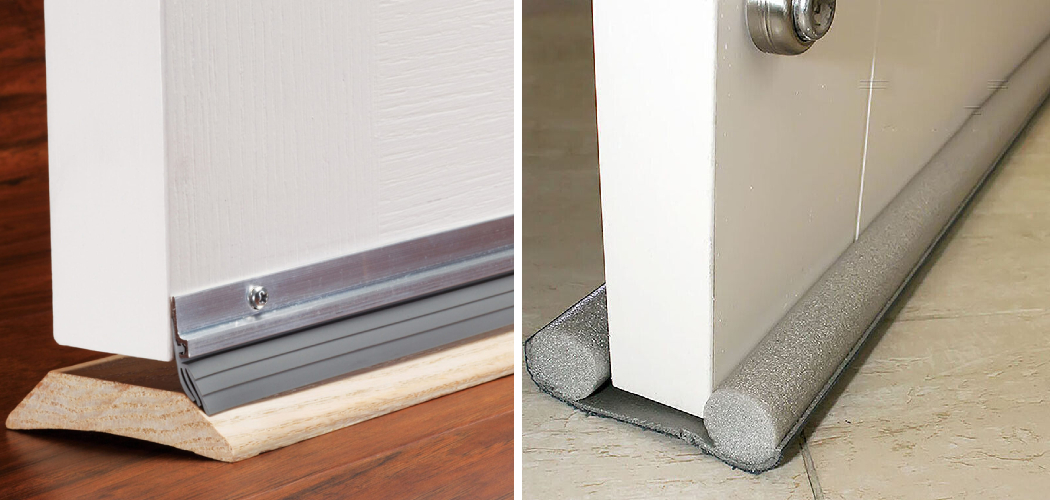Are you dealing with a drafty door that lets in cold air? Are you frustrated by the amount of water that is coming in every time it rains? If so, it’s important to understand why your door might be letting moisture inside and how to properly stop water from entering the space. Here we’ll discuss the common reasons for water entering from under a door and provide easy-to-follow guidance on how to stop water from coming in under door. Read on to learn more!
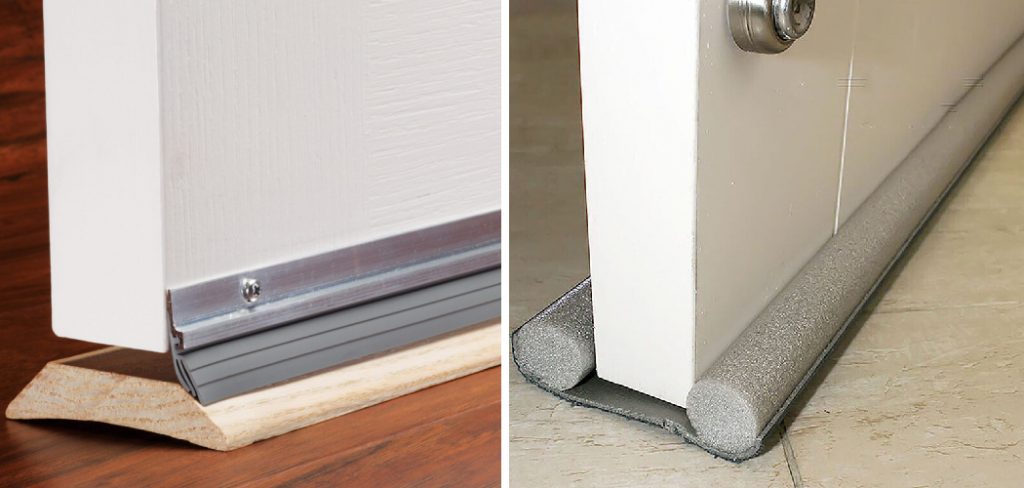
In this blog post, we’ll cover the ins and outs of how to stop water from entering your home via the bottom of your doors. We’ll discuss factors such as proper weather stripping installation, cleaning gutters on a regular basis, and using thresholds or sweep strips to prevent moisture from making its way in. By the end of this post, you will walk away knowing how to successfully create a waterproof barrier that keeps out any unwanted rain or snow.
Why Is It Important to Stop Water From Coming in Under Door?
1. To Keep Safeguard the Home
One of the most important reasons to stop water from coming in under the door is to safeguard the home against potentially costly structural damage. When water seeps into the walls, floors, and foundation of a house, it can lead to mold growth, rot, wood decay, and other issues which can be expensive to repair.
2. Avoid Costly Water Damage
Another reason to keep water from coming in under door is to avoid costly water damage. If the water accumulates against walls, floors or other structural components of a home, it can cause long-term and expensive repairs.
3. Save on Energy Bills
By keeping water from entering through the doors, you can also save money on heating and cooling bills throughout the year. Cold air seeping in through the door can cause drafts in the home and make it harder to keep the temperature consistent.
4. Avoid Mosquito Breeding Grounds
When water pools up around a door, it can create an ideal breeding ground for mosquitoes and other pests. These pests can quickly become a nuisance if not dealt with properly, so preventing them from entering in the first place is the best way to keep them away.
5. Improve Air Quality
Another reason why it is important to stop water from coming in under door is to improve the overall air quality of your home. When water pools up near a door, it can allow for mold spores and other allergens to enter the home, leading to poor air quality and potential health concerns.
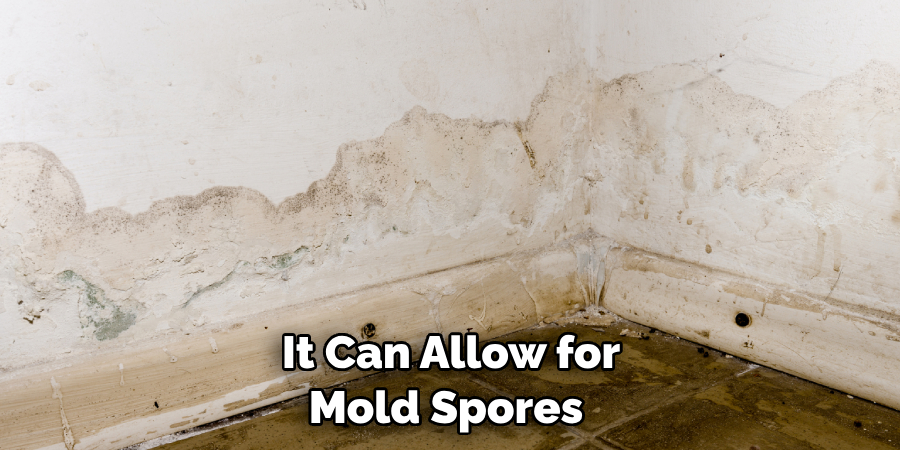
6. Prevent Structural Damage
Water entering a home through the door frame can cause long-term structural damage over time if not addressed quickly and properly. By stopping water from coming in under door, you can help prevent costly repairs down the line and keep your home safe and secure.
7. Enhance Home Security
Stopping water from coming in under the door is important for enhancing home security. Water seeping into the walls and floors can weaken the structural components of a home, making it easier for intruders to gain access.
8. Protect Your Belongings
Finally, stopping water from coming in under door is important to protect your belongings from getting wet or damaged due to flooding. By keeping the water out, you can help ensure that your possessions remain safe and dry.
12 Ideas on How to Stop Water From Coming in Under Door
1. Install a Door Sweep
One of the simplest and most effective solutions to keeping water from coming in under your door is to install a door sweep. Door sweeps are strips of flexible material attached to the bottom edge of the door that press against the threshold when the door closes, creating a seal on either side of it.
2. Apply Weather Stripping
Weather stripping can help you keep moisture out by sealing the gap between the door and frame. This works especially well on wooden doors, as wood is more prone to warping from moisture than other materials are.
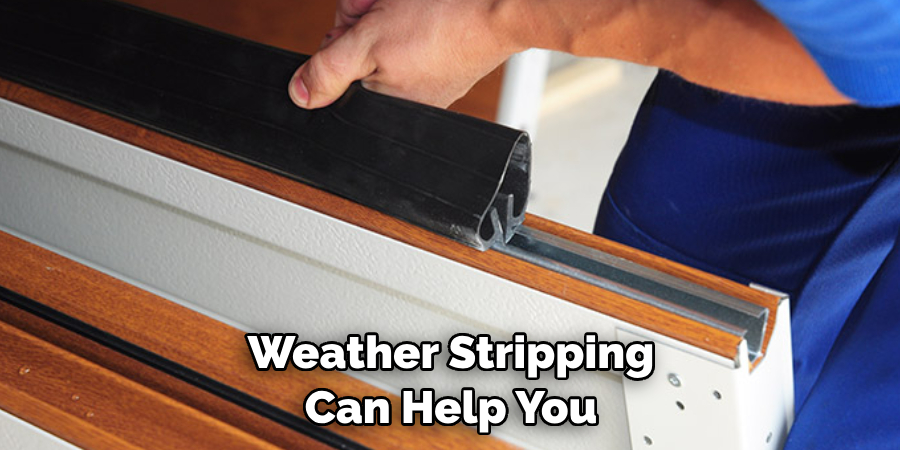
3. Use Foam Tape
Foam tape can be used to fill in any small gaps between the bottom of the door and the threshold, creating an effective seal against moisture. Also, it’s relatively easy to install and won’t require any special tools or knowledge.
4. Replace the Threshold
If your door is particularly prone to moisture coming in from underneath, you may need to replace the threshold altogether. This can be a bit more involved than other solutions, as it will likely require some carpentry skills and tools.
5. Install Aluminum Thresholds
Aluminum thresholds are a great way to keep moisture out from underneath your door. They’re durable and easy to install, and they come in a variety of sizes to fit any doorway. Also make sure that the threshold is sealed properly with silicone caulk.
6. Create a Drip Edge
A drip edge is a strip of metal or plastic attached to the bottom of the door which extends beyond it and prevents water from rolling under the door. This solution can be especially helpful in areas where there’s a lot of rain or snowfall.
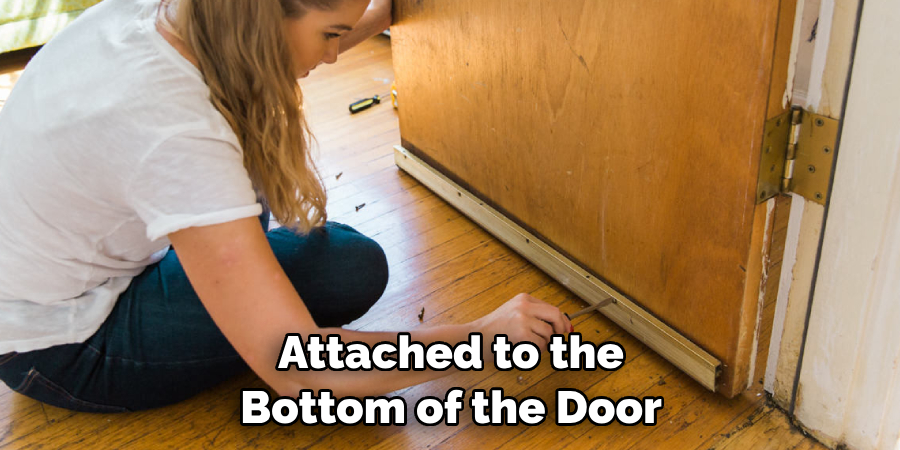
7. Install a Door Bottom
A door bottom is a strip of metal or plastic that’s attached to the bottom of the door and extends beyond it. It helps create an effective seal against moisture and can be found in a variety of sizes to fit any doorway.
8. Use Flashing Tape
Flashing tape is often used in roofing projects, but it can also be used to help keep water from coming in under your door. It’s made of waterproof material and is essentially an extra layer of protection against moisture.
9. Install a Brush Strip
A brush strip is a long strip of bristles attached to the bottom edge of the door which creates a barrier between the door and threshold, preventing water from rolling underneath. It’s an effective and relatively inexpensive solution.
10. Use a Door Gasket
Door gaskets are strips of rubber or neoprene which create a seal between the door and frame, preventing moisture from seeping in from the sides. They’re easy to install and can be found in a variety of sizes to fit any doorway.
11. Apply Caulk to the Threshold
If your door is particularly prone to moisture, you may want to apply a bit of caulk around the edges of the threshold for extra protection. This will help create an effective seal against any water that tries to come in from underneath.
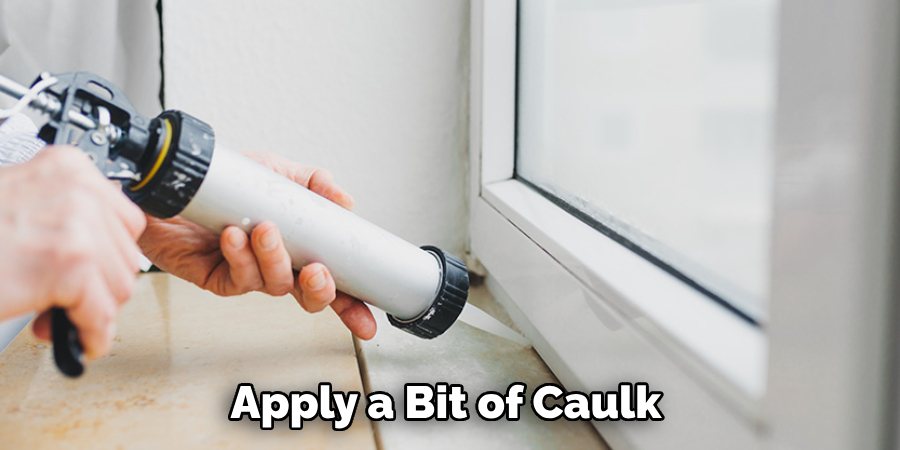
12. Install a Rain Barrier
A rain barrier is an extra layer of protection against moisture coming in from underneath the door. It’s a plastic sheet that fits around the bottom edge of the door, creating an effective seal to keep out any water that may try to come in.
These are just a few ideas on how to stop water from coming in under your door. With a bit of trial and error, you should be able to find the solution that works best for you. Just remember to be patient and take the time to get it right! Good luck!
Frequently Asked Questions
What Precautions Should I Take Before Trying to Stop Water From Coming in Under My Door?
Before attempting any kind of repair, it is important to make sure that the door frame and floor around the door are free from dirt and debris. If there are gaps or cracks in either the frame or floor, they should be filled with caulk before attempting any repairs. Additionally, it’s a good idea to ensure the weather stripping around the door is in good condition and replace it if necessary.
What Are Some Of The Solutions For Stopping Water From Coming In Under My Door?
The most common solution for preventing water from entering your home from under your door is installing a door sweep. A door sweep is a type of device that attaches to the bottom of the door and creates an airtight seal against the floor. Another option is to replace the weatherstripping on either side of your door or increase its thickness, as this can create a barrier between your home and outside moisture.
Additionally, adding a layer of waterproofing membrane to the exterior side of your door can help repel water from seeping in. Lastly, you can create a barrier by laying down a rug or mat that will absorb any water from outside and protect your flooring inside.
Can I Temporarily Stop Water From Coming in Under My Door?
If you need a temporary solution, there are a few options. One way to block water from entering your home is by using towels or rags to create a seal around the door. If the gap between the door and floor is particularly large, consider adding small pieces of wood or foam insulation along the sides of the door to create a tighter seal. Additionally, you can use duct tape or plastic sheeting as a temporary fix until you are able to purchase and install more permanent solutions.
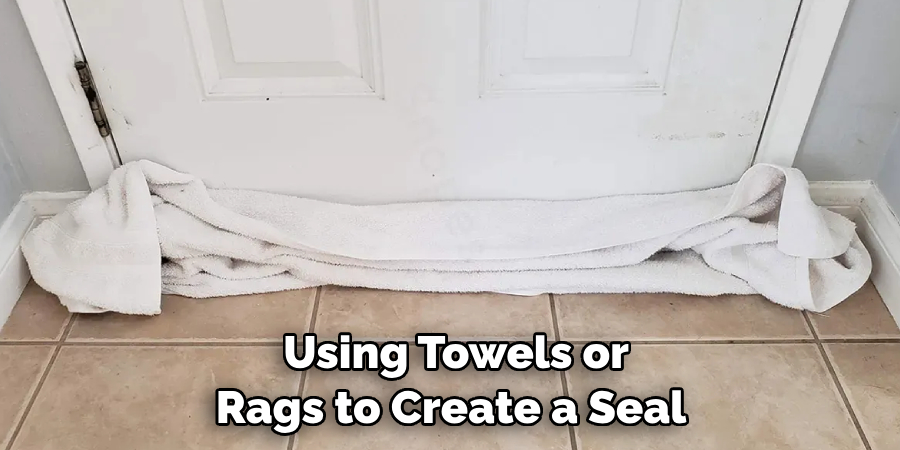
Can I Stop Water From Coming In Through The Bottom Of My Door?
Yes, you can prevent water from coming in through the bottom of your door with a door sweep. A door sweep is a type of device that attaches to the bottom of the door and creates an airtight seal against the floor.
Additionally, you may need to replace or supplement the existing weather stripping on either side of your door to create a better seal and protect against moisture entering from outside. You can also lay down a rug or mat on the interior side of your door to absorb any water that may make its way through.
Can I Seal The Gaps Between My Door And Floor?
Yes, you can seal the gaps between your door and floor. You can use various types of caulk to fill in any cracks or holes around the frame or floor. Additionally, you may need to replace existing weather stripping on either side of your door for a better seal. Lastly, consider laying down a rug or mat on the interior side of your door to absorb any water that may make its way through.
What Is The Best Way To Stop Water From Coming In Under My Door?
The best way to stop water from entering your home is by installing a door sweep. A door sweep is a type of device that attaches to the bottom of the door and creates an airtight seal against the floor. Additionally, you may need to replace or supplement the existing weather stripping on either side of your door to create a better seal and protect against moisture entering from outside. You can also lay down a rug or mat on the interior side of your door to absorb any water that may make its way through.
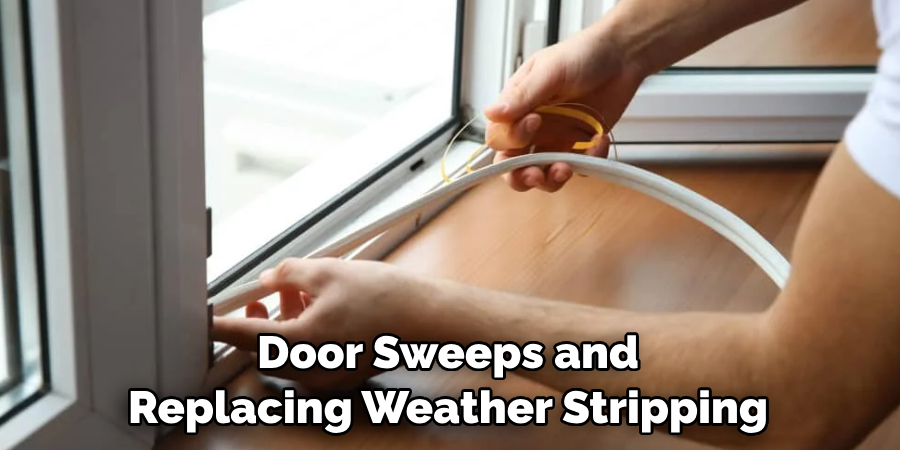
Overall, there are several methods for stopping water from coming in under a door. From installing door sweeps and replacing weather stripping to laying down rugs and using towels, there are a number of ways to keep your home dry and prevent water damage. It is important to take the necessary precautions before attempting any repairs, such as ensuring that all dirt and debris from the door frame and floor are removed.
Conclusion
After reading this post, you should be well-equipped about how to stop water from coming in under door. Whether you decide to invest in a door sweep, add weather stripping, or adjust the threshold, these measures will help protect your home and keep it comfortable during wet weather.
Be sure to keep an eye out for wear and tear over time; if the material looks compromised or is beginning to peel away, it’s important to address the issue right away.
Taking proactive steps to prevent water infiltration into the structure of your home just requires a bit of knowledge and a few simple supplies—it’s really that easy. Hopefully, this post has helped give further insight on how to address the issue of preventing water from coming in under door at home!
